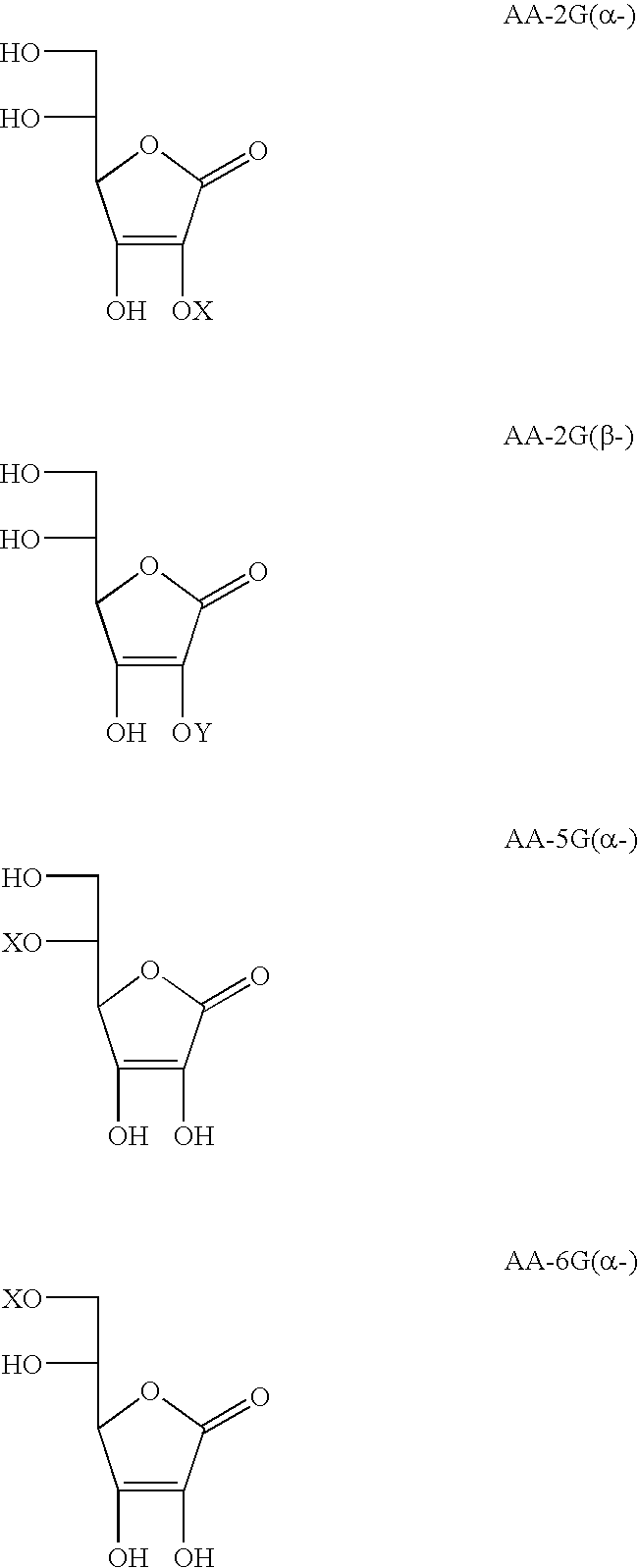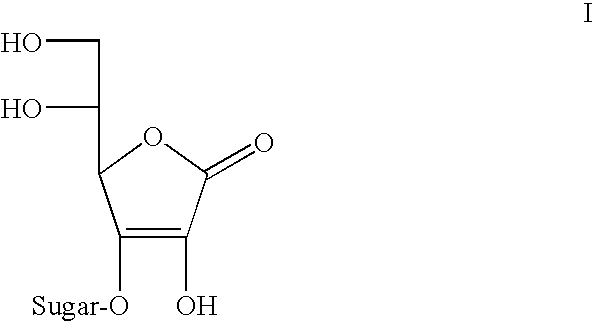Ascorbic acid derivatives, their preparation methods, intermediates and uses in cosmetics
a technology of ascorbic acid and derivatives, applied in the field of 3oglycosyllascor, can solve the problems of loosened tooth and hemorrhagic gum, fragile skeleton, and broken capillaries, and achieve the effects of longer half life, improved stability and improved activity
- Summary
- Abstract
- Description
- Claims
- Application Information
AI Technical Summary
Benefits of technology
Problems solved by technology
Method used
Image
Examples
example 1
Preparation of 1-bromo-hepta-O-acetyl-lactose (3a)
[0050]To a three-necked flask equipped with thermometer and dropping funnel, 180 mL of acetic anhydride was added and cooled to 0° C. in an ice-salt bath, 0.6 mL of perchloric acid was dropped slowly in the acetic anhydride and the internal temperature of the solution was controlled to 0-5° C.; after completion of adding the perchloric acid, the ice-salt bath was moved away. At room temperature, 50.0 g of anhydrous lactose was added in several batches, and the internal temperature of the solution was controlled to 33° C. After completion of adding the anhydrous lactose, the reacting solution was cooled to 10° C., 7.5 g of red phosphorus was put into the reacting solution, stirred to disperse the red phosphorus, then 14.5 mL of bromine was dropped into the reacting solution and the internal temperature of the solution was controlled below 20° C.; after completion of adding the bromine, 10.0 mL of ice-water was dropped and the temperat...
example 2
Preparation of 5,6-O-isopropylidene-L-ascorbic acid (7)
[0051]To a dried 1 L three-necked flask, 91.0 g of ascorbic acid and 450 mL of acetone were added. The temperature was cooled to −5° C. in an ice-salt bath; 200.0 g of concentrated sulfuric acid was dropped slowly for approximately 2.5 hours and the internal temperature of the solution was controlled to 0-5° C., stirred for 5.0 min, then the ice-salt bath was moved away; the temperature was increased naturally to room temperature, and the reaction was continued for 45 minutes; the reacting solution changed from colorless to pale yellow; then the reacting solution was subjected to vacuum filtration under reduced pressure and the filter cake was washed for several times with a small amount of acetone until the pH value was neutral; the filter cake was dried at 50° C. in a vacuum for 1-2 hours and 89.5 g of white solid powder was obtained the melting point of which is 215-217° C. The yield was 80.2%.
example 3
Preparation of 3-O-(hepta-O-acetyl-D-lactosyl)-(5,6-O-isopropylidene)-L-ascorbic acid (4a)
[0052]To a dried 1 L round-bottom flask, 79.0 g of 1-bromo-hepta-O-acetyllactose (3a), 28.1 g of 5,6-O-isopropylidene-L-ascorbic acid (7), and 500 mL of acetone were added, stirred to disperse; next 28.0 g of potassium carbonate, and 1.0 g of TEBAC were added, heated at 50° C. overnight and then was subjected to vacuum filtration; next, the solvent was recovered and a pale yellow oil was obtained; the pale yellow was dissolved with 200 mL of ethyl acetate, washed with 20 mL of saturated salt water for several times, dried with anhydrous sodium sulfate, ethyl acetate was recovered and then the residue was dried in vacuum by a pump for 1 hour, and 57.0 g of bubble-shaped yellow solid was obtained the melting point of which was 52.5-54.0° C. The yield was 60.2%.
[0053]1HNMR (CDCl3, 400M) δ: 1.21 (6H, —CH3), 2.03-2.21 (21H, —CH3), 3.98 (2H, —CH2—), 4.32 (2H, —CH2—), 4.37 (2H, —CH2—), 4.45 (1H, —CH—)...
PUM
| Property | Measurement | Unit |
|---|---|---|
| temperature | aaaaa | aaaaa |
| temperature | aaaaa | aaaaa |
| temperature | aaaaa | aaaaa |
Abstract
Description
Claims
Application Information
 Login to View More
Login to View More - R&D
- Intellectual Property
- Life Sciences
- Materials
- Tech Scout
- Unparalleled Data Quality
- Higher Quality Content
- 60% Fewer Hallucinations
Browse by: Latest US Patents, China's latest patents, Technical Efficacy Thesaurus, Application Domain, Technology Topic, Popular Technical Reports.
© 2025 PatSnap. All rights reserved.Legal|Privacy policy|Modern Slavery Act Transparency Statement|Sitemap|About US| Contact US: help@patsnap.com



